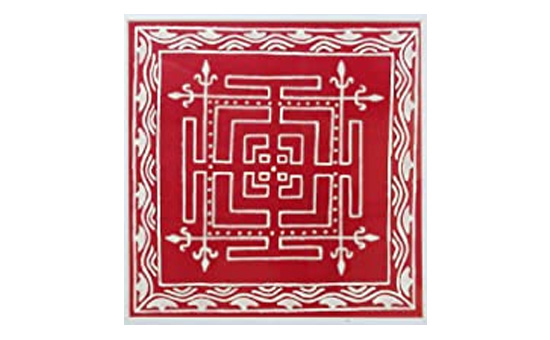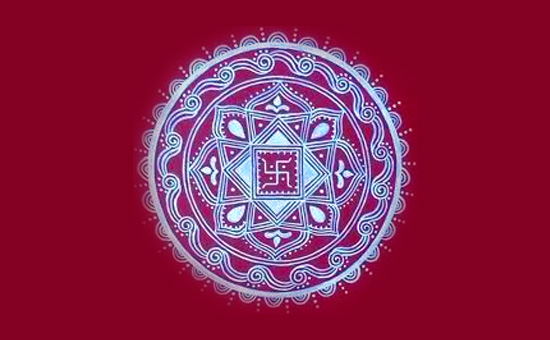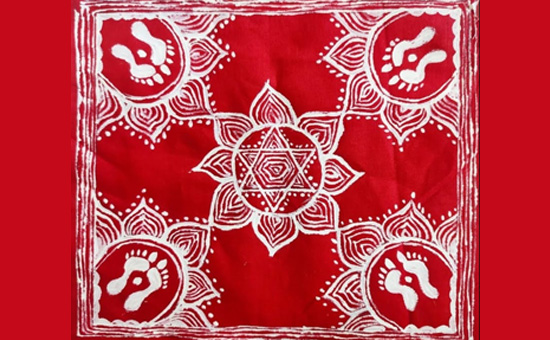- Article
tells about the origin and significance of Aipan art, technique to draw Aipan,
Vasudhaara design, Swastik in Aipan, dots in design, Popular Aipan Product
Applications and more.
Overview
Aipan
is a ritualistic folk art, native to the Kumaon region of Uttarakhand. It is
drawn to commemorate auspicious occasions, festivals and even rituals performed
during death of a person. The art form is also known to offer protection
against evil.
While
earlier, the art form was found on the floors and walls of the houses, today it
has marked its presence in many daily use objects or clothing pieces.
Origin
The
place Uttarakhand, formerly Uttaranchal, is a state in the northern hemisphere
of India. It is a part of Himalayan range that starts form Shivalik foot hills
and stretches to the greater Himalayas.
Uttarakhand has a rich diversity of languages including Hindi, Kumaoni,
Garhwali, Jaunsari, and Bhotiya.
It is a beautiful state with a treasure of Arts and Crafts heritage and second to no other state of the country. It has its own individuality in temple architecture, painting, jewellery making, wood carving, candle making, and also in the performing arts like dance and music. The famous crafts here are cultural windows and doors, woollen rugs and carpets, copper utensils, bamboo baskets, and folk art like Aipan taken from the Sanskrit word “Lepana” (means doing Plaster).
Significance of Aipan Art
Folk art in India is
extremely diverse. Even within a particular state, you will find numerous kinds
of folk art, and they usually come into play at special occasions, such as
festivals, marriages or religious purposes. The Himalayan region in India is
vast, with different cultures residing throughout its length and breadth.
Today,
we will look at a particular art form that is native to
the Kumaon region of Uttarakhand, called Aipan. It is a ritualistic
folk art form.
Aipan
is drawn on a smooth surface that is prepared using wet ochre mud, known
as geru, which is red in colour.
A white paste is made by grounding cooked rice in water. This paste is known
as bisvar and is used to
draw patterns on the surface. The women use their fore, ring and middle finger
to draw the patterns.
The
motifs and designs are inspired by the religious beliefs of the community and
the natural resources around them. They generally include conch shells,
creepers, floral patterns, swastika, footsteps of goddess, geometric designs
and figures of gods and goddesses. The linear lines drawn in Aipan are symbolic
to the ritual or festival it is drawn for.
Technique to draw Aipan
The
art form is made by women, and the knowledge is passed on through the
generations from mothers to daughters. The creation of an Aipan begins and ends
with a dot.
The
dot, which is placed in the center, symbolizes the center of the universe. From
this center, all other lines and patterns emerge which indicate the shifting
form of the world around it.
Aipan of Door Steps
Doorsteps of the house are decorated with this kind of aipan. These are beautifully designed decorative aipan with great aesthetic value. The door steps are decorated with this type of aipan in combination with ‘Vasudhara’ the vertical lines made by dripping the ‘biswar’ (Rice floor solution made by soaking the rice and then grinding it which is used for drawing aipan).

Vasudhaara Design
Pooja
Vedika, door steps of house, Place of worship, Tulsi (A structure made around
the Tulsi Plant) etc. are decorated with vasudhara.
Without Vasudhara, Aipan are considered incomplete. These are made by painting the place with ‘Geru’ (filtered red colour soil) and thereafter making vertical lines by dripping ‘Bishwar’ (soaked rice powder). The dripping of ‘biswar is carried out by Anamika (Ring finger). These are drawn in the blocks consisting lines in odd numbers like 5, 7, 9 or 11.
Swastik Symbol
Swastik
has great significance in Aipan. It is drawn in some form or other during most
of the religious rituals.
If
someone does not have the knowledge of the occasion specific Aipan, Swastik is
religiously accepted as substitute. Swastik represent the creation and
progress. All four arms of Swastik inspire to move forward. Thus, Swastik is
the symbol of marching ahead for success, towards success with success.
Dots in Design
Different lines joining at rectangle represented different religions. These all lines join each other at the center which is the place for ‘Omkar’. The lines are surrounded by dots, which too have a special significance.
Any
Aipan without dots is considered incomplete and inauspicious. During drawing the Aipan, one has to take care that the group or block of lines in traditional Aipan should end with the dots. Aipan without dots are drawn on the 12th day of someone’s death (Peepal Pani or Shanti Path). On third day, these Aipan
without dots are removed and fresh aipan with dots are drawn signalling end of mourning period.
Astadal Kamal
This aipan is drawn at the place where ‘Havan’ is performed. It is an octagonal geometry with lotus petals and a swastik drawn at the center.

Lakshmi Padchinha
On
Deepawali day, footprints of Goddess Lakshmi are drawn from main entrance of
the house to place of worship.
Lakshmi
Peeth
This
aipan is drawn at the poojasthal (place of worship) where worship of Goddess Lakshmi, the goddess of wealth and prosperity, is performed.

Bhuiyan
Bhuiyan refers to the negative & harmful powers or bad omen. This is drawn on outer side of a ‘Soop’ which is generally a very ugly and bad looking sketch of a demon. On the inner side of the ‘soop’ Lakshmi-Narayan are drawn.
On a particular day, this ‘soop’ is beaten with a sugarcane stick at every room and corner of the house. This refers to ousting of bad omen, ill fate or negative powers and welcome of Lord Vishnu and goddess Lakshmi, the God/Goddess of happiness and prosperity.
Dhuliarghya Var Chauka
At
the time of Dhuliarghya, the
bridegroom is made to stand on the Chauka when introduction and welcome of
bridegroom is performed by chanting vedik mantra.
Acharya Chauka
Acharya, ‘the kulguru’ who performs the marriage rituals from bridegroom’s side stands on this chauka at the time of dhuliarghya.
Janeo
At the place of ‘Janeo’ or threading ceremony, drawing this aipan is mandatory. This drawing has 15 dots in the center. Traditional it is also drawn at the place where men change their ‘janeo’ on Raksha Bandhan day.
Bhadra
It
is drawn at the place of worship and yajna. Bhadra are of various forms
depending upon the number of dots such as 12 Bindu bhadra, 19 Bindub hadra, 24
Bindu bhadra and 36 Bindu bhadra etc.
Jyuti
Sixteen mother goddesses are worshiped after worshiping Lord Ganesha for trouble free execution of any task in hand or ceremony undergoing. These are called ‘matrika’ or ‘Jeev Matrika’ or ‘Jyuti’ in kumaoni. To perform pooja of these goddess’, they are drawn on wall or on a board or paper now a days. Lord Ganesha is drawn in right side and matrika in left side.
Namkarna Chauki
Naming
ceremony of a newborn is held on eleventh day. This is the first time when the
baby is exposed to sun / open atmosphere (Surya darshan). This alpana is drawn
in the courtyard where the surya darshan is performed.
Popular Aipan Art Product Application
Chowkies
are made of Mango wood and painted with special designs on auspicious
occasions. Pattas and Thapas are made directly on the walls or on paper and
cloth.
Earlier
the paint used was made from Natural Dyes. Today both poster paints and oil
paints are used.
Traditional patterns are getting used in cards, wall hangings, cushion covers, table cloths and T-Shirts. The other decorative patterns are been used on gift-tags, bookmarks, clay items, wooden boxes, trays and coasters.
The
purpose of this compilation is to document and promote. We have given credits
and reference links in this compilation. In case some are missed, it is not
with malafide intent.
To read all
articles by author
To
see videos on Aipan and additional reading
Also
read
1.
Pics
Woollens Munisyari Kumaon
2.
In
Hindi, Traditional Holi Kumaon
3.
Paintings
of Traditional Dress and Ornaments of Kumaon and Garwhal
4.
Close to
1,000 pictures on Kumaon
